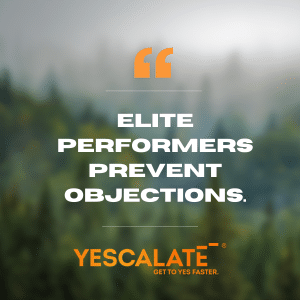Understanding the difference between objection handling and objection prevention—and between objections and conditions—can immediately improve your sales performance. And it’s not just technique——it’s brain science and at the core of essential sales best practices.
Here’s the truth:
Your top reps aren’t “handling” objections…
They’re preventing them.
They identify the question in advance—and answer it before it is even asked.
Teaching underperforming reps how to handle objections might offer short-term gains. But if you want to double your sales performance, the real lever is teaching them how to prevent objections in the first place.
➡️ Getting a better understanding of objection and condition is vital.
Start with this concept— In the situation is the prospect presenting us with an objection or a condition?
An objection is a question or statement that can be reframed and answered. A condition is a fact, the presence of which cannot be reframed.
Here are two statements-one is an objection, one is a condition.
Let’s say we sell shoes and the prospective customer says:
“I already have shoes”
Which category does that statement fall into- objection or condition?
It is an objection.
The customer is asking “Why should I buy THESE shoes?” What is different, better?
How about if the prospect says:
“I don’t have feet”
Is it an objection or a condition?
It is a condition.
Unless the prospect is buying shoes for another purpose (as a gift maybe for someone WITH feet?) then this prospect is not in any stages of the buying cycle for shoes.
➡️ The difference between objection handling and objection prevention.
Objection handling results when the PROSPECT voices a question that the Sales pro has to answer— this places the Prospect in the position of being in control, creating the context and now having to stay committed to the objection, none of those things are beneficial to moving the sales process forward and buying from us.
Objection prevention Is the result of the sales professional identifying in advance before the prospect says it what the prospect’s questions are and answering them before they come up. This puts the sales professional in control, creating the context and also applying the commitment and consistency theory, which are ALL in the sales professional and the prospects best interest. And moves the shared buying process forward.
That’s where the YESCALATE® process comes in. It’s not luck. It’s a science-backed system to get to yes—faster and more often.
One tool that can help? The LEAP Model:
… all before you try to problem solve.
So what does LEAP really do?
It sets the stage for collaboration—not conflict.
By finding common ground, you’re using what psychology calls the liking principle and the power of unity (we, us, our). These small shifts increase trust, lower resistance, and even trigger oxytocin—the brain’s “connection chemical.”
This isn’t theory. It’s the CBOK—the core body of knowledge for high-performance sales. And it’s why elite reps have known for decades:
Objection prevention eats objection handling for lunch.
Models like LEAP, along with Brain’s GPS™, and the One-Page Sales Coach® aren’t just frameworks. They’re forcing mechanisms—designed to cue the behaviors that lead to:
✅ More sales
✅ More growth
✅ More customer impact
✅ More profit
For you. For your team. For your customers. Ready to YESCALATE®?






